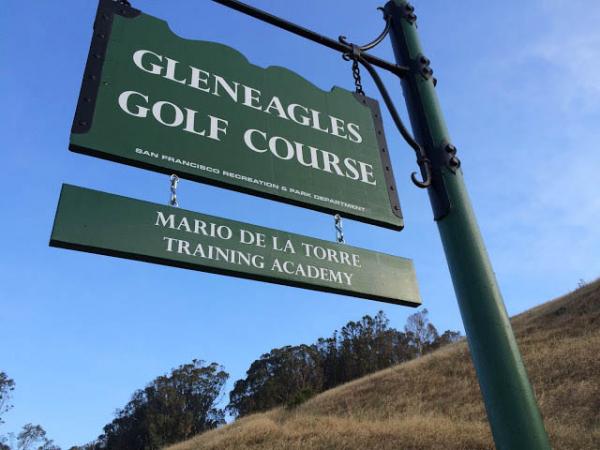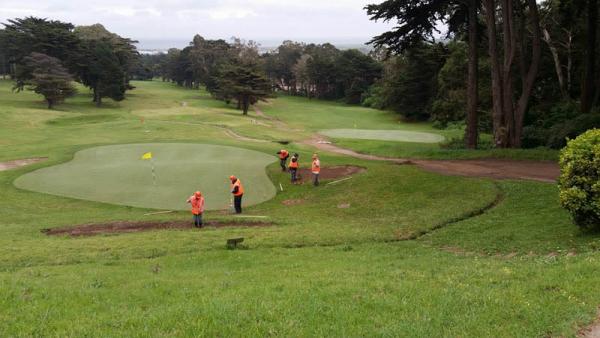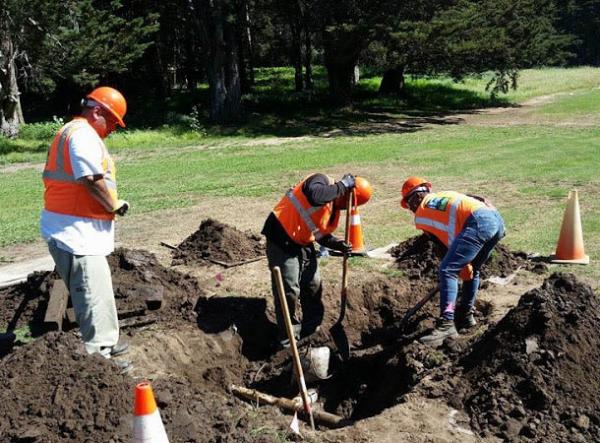Driving to work each day in one of San Francisco's most dangerous neighborhoods, Tom Hsieh feels a sense of satisfaction that the golf course he has overseen for the past dozen years is helping provide a leg up to those who need it most.
 Located between the downtrodden Excelsior and Visitacion Valley neighborhoods on the city's southeast side, Gleneagles Golf Course has been defying the odds since the Jack Fleming design opened in 1962 just up the hill from the then-new Candlestick Park.
Located between the downtrodden Excelsior and Visitacion Valley neighborhoods on the city's southeast side, Gleneagles Golf Course has been defying the odds since the Jack Fleming design opened in 1962 just up the hill from the then-new Candlestick Park. For more than a decade, the course has served as a First Tee facility, giving at-risk youth a pathway to golf and the principles that prop up the game. For the past year, through a job-training struck with a local labor union and multiple municipal agencies, Gleneagles is providing dozens of adults down on their luck with a new career skills and a new lease on life.
"There are a couple things that have been really special in my experience at Gleneagles, which is now 12 years as a manager," said Hsieh, owner of Gleneagles Golf Partners that leases the course from the city. "I did not get into this business to change lives. I wanted to save a golf course and keep it going for myself and for the next generation. That was my altruistic purpose.
"When we opened up to The First Tee, I saw how golf can change lives. I saw kids who were 7 years old, and who are now 15-17 years old and who have stayed with it and who have become not only good golfers but great people. They are all from the neighborhood. They are all black and brown kids who would not be playing if not for the access to this neighborhood golf course.
"The second thing is this apprenticeship program. This is a totally different part of the community, but the same racial profile of people. They are black and brown, Asian as well. They are older, and they've had some really hard luck, some of it self-inflicted but they are on the side where they want to do better, and they've been given this - I don't want to say second chance, because for a lot of them they are well beyond that - but given this chance to improve themselves through this program. And the vast majority of them are taking advantage of that program. And that is really rewarding personally to watch that happen."
Named for a local union leader, the Mario de la Torre Training Academy provides union pre-apprenticeship training for up to a dozen low-level city workers, most of whom come from a broken past that includes run-ins with the law and time behind bars.
As many as 12 workers at a time are recruited from throughout various city departments to learn in incremental steps how to work on a golf course, starting with pulling weeds and clearing debris to eventually raking bunkers and operating power equipment. After each six-week session,"graduates" receive a union pre-apprenticeship certificate that allows them to apply to complete apprenticeship training so they can compete for other union jobs offering better pay and benefits.
A storage facility at the golf course has been repurposed - thanks to union-provided labor - into a classroom to help facilitate training.
The program is a joint effort that includes the Northern California District Council of Laborers, Local 26 and a host of city and county agencies (parks alliance, public utilities commission, public works, housing authority, department of environment, chief administrator's office, board of supervisors, mayor's office, unified school district).
The academy's goal is to equip at-risk residents with training and skills needed to be successful at work and in life. Two managers employed by Local 261 handle all training, which includes basic maintenance, operating basic equipment, introductory IPM, pulling weeds and safe tree management.
Workers spend the first week in Gleneagles' new classroom, learning golf course etiquette and how to act on the property.
"They are tooled up on safety instruction and what it means to be on the golf course, stuff that if you're not a golfer, you just don't know," Hsieh said. "They learn a lot of soft skills in that first week, in fact in all six weeks."

The city and Gleneagles budgeted for as many a total of 80 people to work at Gleneagles across five separate six-week sessions in the first year. A total of 63 people went through the program in its first 12 months, including a dozen graduates who secured city jobs with union wages. As soon as one six-week session ends, the next begins.
"They were taking one-week breaks between sessions, but now they are going end to end," Hsieh said. "We are happy to have them and have the help all the time."
Workers are paid through their city jobs while working at Gleneagles. A fundraiser golf tournament helped raise money to contribute to the program so it can continue into the future.
While elected leaders in Washington, D.C., talk about the need to retrain the underemployed for a brighter future, Hsieh and public officials in San Francisco are actually doing it.
"The vision is to create job training and career pathways for people who are underskilled and underemployed," Hsieh said. "It takes six different city departments to make this happen. It's a very large effort to ask the city to be partner with a private entity."
Two union managers handle all training and discipline. Workers are required to wear a uniform, steel-toed work boots and a hard hat, and they are expected to be on time. Hsieh said he is amazed to watch the workers grow into the position as each six-week session progresses.
"They look bedraggled the first week," Hsieh said. "No one tells them how to dress. By week three, they get it. They carry themselves in a different manner, because now it is getting serious; they are working with power tools, they have been taught how to mix oil and gas and they're mowing tees.
They are constantly evaluated as they go by their managers. If they don't show up on time, they get released. They are expected to be on time, prepared to learn, have a positive attitude and a team dynamic. All of them want to better themselves."
 The program has transformed Gleneagles into much more than just a forgotten golf course in a forgotten part of the city. For some, it represents a promise for a future that didn't exist before.
The program has transformed Gleneagles into much more than just a forgotten golf course in a forgotten part of the city. For some, it represents a promise for a future that didn't exist before. "Gleneagles is in a neighborhood in one of the worst parts of the city. That has become a strong point for the program," Hsieh said. "It is now a community resource, because the people in this program are from this neighborhood. They are now a success and they can walk to work."
City-owned Gleneagles never has enjoyed the perks of Harding Park, its well-heeled municipal sibling that rims Lake Merced on the city's west side, at least not since Hsieh has run the course.
While Harding Park was flush with union labor, Gleneagles' success (or failure) largely was left to the imagination and slight of hand of whoever leased it from the city. For the past 12 years, that has been Hsieh. He puts his own money, not the city's, into the course and gets to keep the profits if there are any, and usually there aren't any.
At the same time the PGA Tour was in talks to bring a host of championship events to Harding Park, gunfire echoed in the neighborhoods around Gleneagles - literally. While the course was undergoing a restoration project seven years ago, a stray bullet screamed through the cab of piece of equipment, missing the operator (an employee from the nearby California Golf Club of San Francisco) by mere inches.
Although there wasn't much Hsieh could do about neighborhood crime, he knew something had to change about how the barebones way in which the golf course was managed.
With only two full-time employees on the golf course working tirelessly to keep Gleneagles playable, years of deferred maintenance were taking a toll. Debris and dead or dying trees cluttered the edges of the property.
In 2014, he entered into negotiations with the Local 261 and city agencies to start a program that would provide much-needed labor help on the golf course, would give the city's at-risk community a chance for a new start and the union an avenue to train them.
Union workers spent much of the first year learning how to clear debris and trees using a skid steer and other equipment and haul everything off the property. There is enough work to keep workers in the union program busy for years.
"This program just happens to have met the needs of each party," Hsieh said. "The union needed a site for their workers, workers needed new training and we certainly can use the help. The concept of turning our site into a classroom made sense. There is still so much work that needs to be done."

